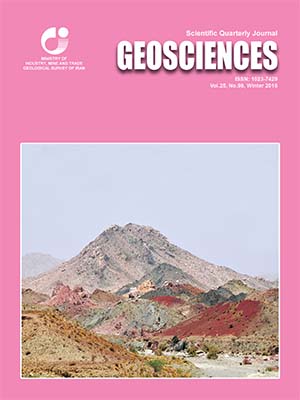Document Type : Original Research Paper
Authors
1 Ph.D. Student, Department of Geology, Faculty of Earth Sciences, Shahid Beheshti University, Tehran, Iran
2 Assistant Professor, Department of Geology, Faculty of Earth Sciences, Shahid Beheshti University, Tehran, Iran
3 Associate Professor, Department of Geology, Tarbiat Modares University, Tehran, Iran
4 Professor, Department of Earth Sciences, Laurentian University, Sudbury, Canada
Abstract
The Daraloo and Sarmeshk copper deposits lie in a northwest-trending fault zone, 10 km long and 0.5-1 km wide in the southern section of the Kerman copper belt, south Iran. The area is marked by a series of Late Eocene-Oligocene granodiorite and Miocene porphyritic tonalite-granodiorite intrusions that cut Eocene andesitic and basaltic lava flows and pyroclastic rocks. Mineralization in both deposits is associated with the Miocene porphyritic intrusions. Both volcanic and plutonic rocks are intruded by post-mineralization diabasic, andesitic and rhyolitic dykes. Representative samples from various rocks were analyzed for major oxides and a wide range of elements. The samples display calc-alkaline affinities; the volcanic rocks are metaluminous, and the intrusive rocks are peraluminous. On primitive mantle- and chondrite-normalized plots, all rocks are characterized by enrichment in large ion lithophile elements and light rare earth elements, relative to high field strength elements and heavy rare earth elements. The features, combined with the negative anomalies for Nb, Ta, and Ti, are characteristic of the subduction- related magmas.The Miocene tonalites are most fractionated, with LaN/YbN ratios ranging between 7.81 and 18.21. This ratio in granitoid rocks is between 6.61 and 7.56. The volcanic rocks are least fractionated, with LaN/YbN ratios from 1.52 to 5.16 .The geochemical attributes of the intrusive bodies from both Daraloo and Sarmeshk are consistent with significant contribution from sediments and crustal materials in the source area, compared to that introduced by fluids released from a subducting slab. The volcanic rocks are, however, appear to have been least affected by crustal materials, but slightly influenced by slab-derived fluids. Plots of samples from all plutonic and volcanic rocks on various discrimination diagrams indicate a transition from an island-arc setting in Paleocene-Eocene to a continental margin volcanic arc setting in Neogene. This is in agreement with earlier works on the evolution of the Kerman belt.
Keywords

